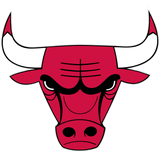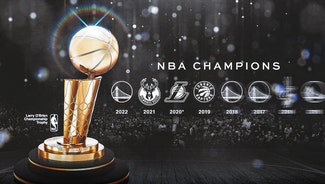
A 3-step process to fix the NBA's tanking problem
The NBA seems to have a lot of problems these days — players are resting too often because the schedule is too grueling, the MVP race is a contentious battle of old school and new school ideologies, the defending champions’ defense stinks, and the Chicago Bulls might make the postseason.
Oh, and there are several teams trying to lose every single one of their games down the stretch.
Tanking is a huge issue in the NBA these days, and it comes in all shapes and sizes. There's The Process, the pick protectors and teams that say "forget it, we might as well wear this stink." Teams are probably hiring consultants right now to think of new, creative ways to tank and land Michael Porter Jr. in the 2018 NBA Draft.

I get why tanking happens — this is big business, and there’s no value in being mediocre in the Association.
But tanking is becoming more and more common every year, and that’s hurting the league in ways we can’t even see yet.
And here's a basic truth: If you do something often enough, you'll become good at that thing — in the case of teams that are tanking, that thing is losing.
The system is broken, so let’s fix it.
Here’s a bold, but not-quite-radical three-step process to make that happen:
STEP 1: GET RID OF ALL THE DRAFT PROTECTIONS
No other North American professional sport does anything like this. It was a clever idea — a Wall Street-style creation to hedge a bet and a new way to theoretically equalize value in trades — but it has gone too far.
If you’re going to trade a draft pick, trade a draft pick — adding 23 caveats to a first-round pick so that it will eventually turn into the Orlando Magic’s 2021 second-rounder and a free Southwest Airlines drink ticket is ridiculous and only adds incentive for teams to lose, sometimes for years on end, stuck in protected-pick purgatory.
NBA transactions should not be as complicated as the tax code.

So no pick swaps, no protections, no more "Atlanta's 2017 second-round draft pick to Philadelphia (if Atlanta not protected: swap, least favorable of Utah, Detroit, Golden State and New York incoming)" — a real situation that will have to be parsed out in this year’s draft.
Hell, we live in a world where teams can place protections on unprotected picks that were traded to them.
That kind of nonsense is done. If you trade your first-round pick and it turns out to be No. 1, you lost. If it’s No. 30, you won more than just a title. It doesn’t matter if this stifles trades at the deadline or decreases player movement — and it’s not as if it should go because it’s too complicated and hurts my mind grapes. It has to go because it’s part of a system that encourages the worst kind of losing — specific losing.
It might take some time for all the existing obligations to come off the board, but henceforth, pick protections are banned.
STEP 2: TOTALLY CHANGE THE LOTTERY SYSTEM
I was a proponent of “The Wheel,” a system where draft picks are randomized for the next 30 years, with every team getting every one of the 30 spots over that period of time — but in the years since that proposal came to pass, it’s clear that me and my fellow Wheelies are a small club. I understand the reluctance to adopt that system. (It's too good!)
But the current lottery is broken, as it was built with the assumption that everyone would try to win.

One superstar can change a team's trajectory, and though luck should be part of the draft process — lest we have non-playoff teams tanking even harder and faster and longer to guarantee a prescribed high draft pick — the number of lottery teams is too broad and doesn’t reward losing enough.
Yes, it doesn’t reward losing enough. The answer? Reduce the number of teams that qualify for the lottery.
A six-team lottery isn’t perfect — there is no perfect system (besides The Wheel) — but it’s my belief that it would effectively tranche the NBA’s worst teams and funnel them the players they need, without too much luck getting in the way.
Team No. 1 (or No. 30, depending on your viewpoint) would have a 30 percent chance at the No. 1 overall pick. No. 2 — 24 percent; No. 3 — 19 percent; No. 4 — 14 percent; No. 5 — 9 percent; No. 6 — 4 percent. (The worst team gets one extra ping-pong ball, you know, for the effort.)
Let’s call that the Super Lottery.
So what happens to the other lottery teams with this new Super Lottery? They join a big, burgeoning middle class.

The (regular) lottery will now consist of the eight remaining teams that didn’t make the postseason and the eight teams that were eliminated in the first round of the playoffs.
Teams that don't make the postseason will have an advantage in landing the top pick (No. 7) in this lottery — the eight non-playoff teams will have descending odds from 12 percent to 5 percent, but the playoff teams will all have a 4 percent chance to land that top pick.
This new, 16-team, middle-of-the-pack lottery is meant to reflect that there’s not much difference between the 35-win, No. 10 team in the Western Conference and a team with a .500 record in the East that somehow has the No. 6 seed in the playoffs. Are the Chicago Bulls really in a different class than the Minnesota Timberwolves this year? Of course not, and the separation hasn’t been there for years — so why should the draft give the Timberwolves a 10 percent chance at a top-three pick and have the Bulls pick outside of the lottery?
Unless the NBA wants to eliminate conferences and go to a true round-robin schedule (it doesn't), a third class needs to be added to the fold.
STEP 3: DON'T DETERMINE LOTTERY POSITION BY RECORD
This is a tricky one, but stick with the thesis.
For the same reason we need a middle class — a section of playoff-contending teams that aren’t quite exceptional — we need to determine both Super Lottery and (regular) lottery order by date of elimination from the playoffs.
Yes, it’d be a race to the bottom in many cases, but it’d be over fast for the worst teams. Would the Phoenix Suns have lost their last 10 games this season if their lottery spot were determined last month? No — they’d try stuff out, they’d get better. They wouldn't bench their best player in hopes they could lose enough games to get another good player.

There’s still a lottery, so you can’t deliberately lose your first 40 games and guarantee the No. 1 overall pick. But if teams are going to play poorly on purpose — and the cat is out of the bag on that one, teams are always going to tank — it’s best to not have a system that necessitates 82 games of garbage.
Meanwhile, there's not much incentive for the (regular) lottery teams to not go for the playoffs — you're not going to get a top-six pick, and is an 8 percent better chance at pick No. 7 worth losing goodwill with your fans?
The elimination-date system would also better reflect different likelihoods of making the playoffs in each conference. The Suns are further away from making the postseason in the loaded West than the Sixers in the East — why isn’t that reflected in the current system? By comparing teams to their conference counterparts, we have a better understanding of which teams need the help more.
Perhaps bad teams, looking at an outside shot of making the postseason at the beginning of the year, will actually go for the winning option if there isn't a terribly harsh penalty for actually playing hard. There's far less no-man's land to be found.
Maybe it's a pipe dream — teams will just set course on the most craven path to start the year — but something has to be done.



